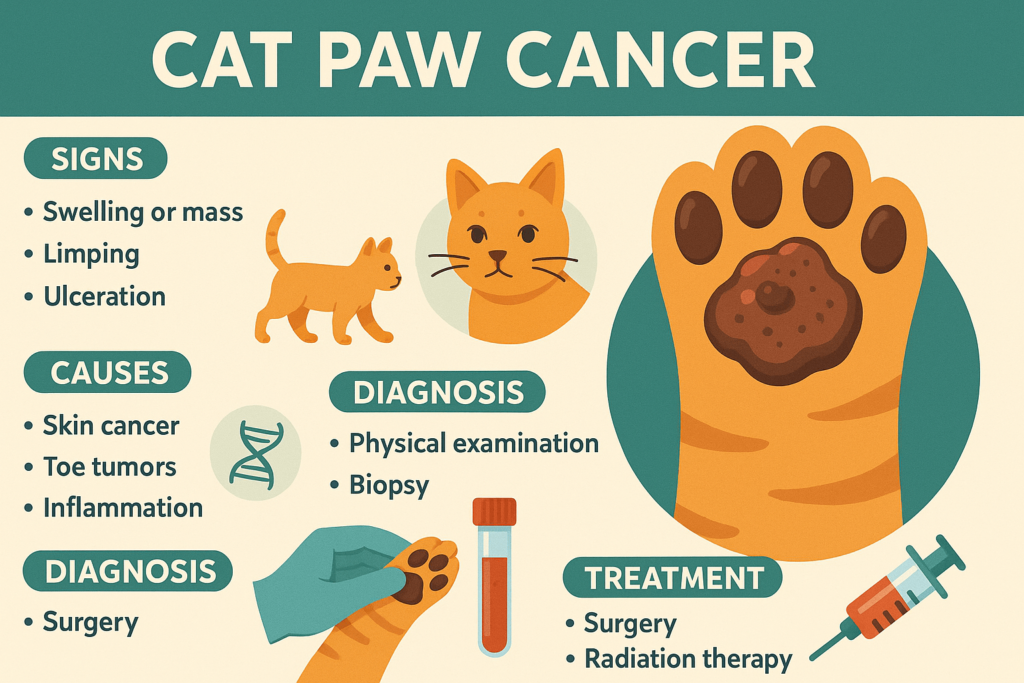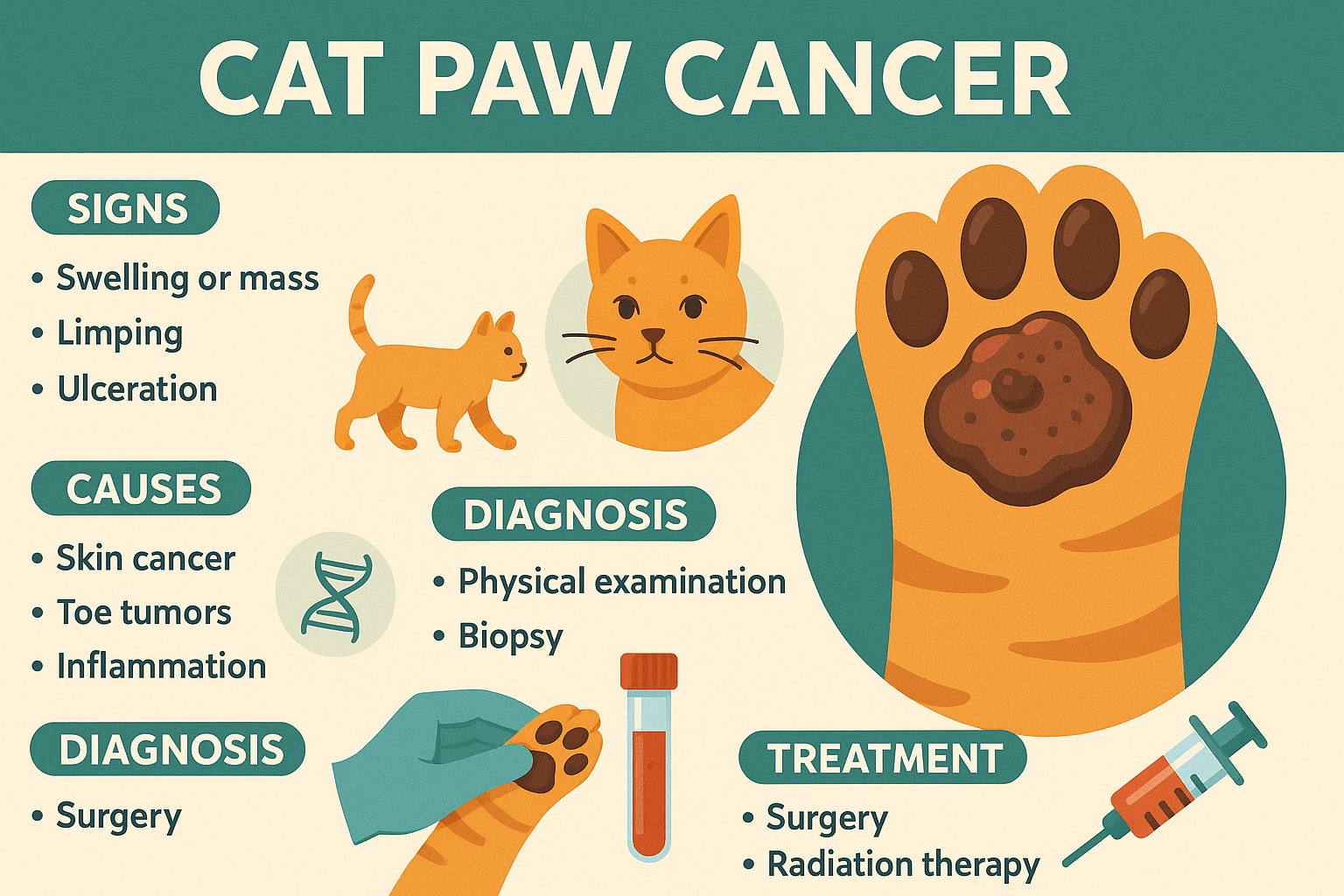Understanding Cat Paw Cancer: Causes, Symptoms, and Treatment
Cancer is a devastating diagnosis for any pet owner, but when it affects sensitive areas like a cat’s paws, it can be particularly alarming. Cat paw cancer, though relatively rare, is a serious condition that requires prompt attention to ensure the best possible outcome for your feline companion. Early detection and proper treatment are crucial in managing this disease effectively. In this blog post, we’ll explore what cat paw cancer is, how to identify symptoms, and what steps you can take to support your cat’s health. Whether you’re a concerned pet parent or simply looking to stay informed, this guide will provide valuable insights into understanding and addressing this challenging condition.
Expert Opinion on Malignant Tumors
“Malignant tumors are those that are invasive, aggressive, fast-growing, cancerous, and tend to spread to other parts of the body. Metastasis is the spreading of the cancerous cells from the primary tumor location to another part of the body via the blood or lymphatic systems.”
Common Types of Cat Paw Cancer
Cat paw cancer can manifest in various forms, each with its own characteristics and treatment approaches. Understanding these types is essential for recognizing potential issues early on.
Squamous Cell Carcinoma:
This is one of the most common types of cancer affecting cats’ paws. It often appears as sores or ulcers that don’t heal.Melanoma:
Melanoma in cats can occur on the paw pads and is typically identified by dark, irregular growths.Fibrosarcoma:
A malignant tumor that originates in the connective tissue of the paw, fibrosarcoma can cause swelling and discomfort.Basal Cell Carcinoma:
Though less aggressive, this type of cancer can still affect the skin of the paw and may require surgical removal.Mast Cell Tumors:
These tumors can develop on the paws and often cause redness, swelling, or itching in the affected area.
Recognizing these types of cancer can help you seek timely veterinary care and improve your cat’s chances of recovery.

Signs and Symptoms of Cat Paw Cancer
Detecting cat paw cancer early can make a significant difference in treatment outcomes. Keep an eye out for these warning signs that may indicate a problem.
Persistent Sores or Ulcers:
Open wounds on the paw that refuse to heal could be a sign of squamous cell carcinoma or other cancers.Swelling or Lumps:
Unusual growths or swelling on the paw should be examined by a veterinarian to rule out malignancy.Lameness or Difficulty Walking:
If your cat suddenly limps or avoids putting weight on a paw, it could indicate pain caused by a tumor.Changes in Nail Growth:
Abnormal nail growth, such as thickening or brittleness, may signal underlying issues, including cancer.Discoloration of the Paw Pad:
Dark spots or changes in the color of the paw pad can sometimes indicate melanoma or other conditions.
Being vigilant about these symptoms allows you to address potential problems before they worsen.
Check this guide 👉Understanding Cat Skin Cancer: Best 7 Expert Tips!
Check this guide 👉Understanding Cat Nose Cancer: Best 7 Expert Tips!
Check this guide 👉Understanding Breast Cancer in Cats: Best 7 Expert Tips!
Preventive Measures for Cat Paw Health | Steps to Take if Cancer Is Suspected |
|---|---|
Regularly inspect your cat’s paws for abnormalities | Schedule a vet appointment immediately |
Provide a safe environment free of sharp objects | Avoid delaying diagnosis and treatment |
Monitor for changes in gait or behavior | Request a biopsy or imaging tests for confirmation |
Keep your cat’s nails trimmed and clean | Discuss treatment options with your vet |
Maintain a healthy diet to boost immunity | Stay informed about available therapies |
Diagnosis and Treatment Options for Cat Paw Cancer
If you suspect your cat has paw cancer, understanding the diagnostic process and available treatments can help you navigate this challenging time.
Physical Examination:
Your veterinarian will conduct a thorough physical exam to assess the affected area and gather initial information.Biopsy:
A small tissue sample may be taken to determine whether the growth is benign or malignant.Imaging Tests:
X-rays, ultrasounds, or MRIs can help identify the extent of the cancer and whether it has spread.Surgical Removal:
In many cases, surgery is performed to remove tumors and prevent further complications.Radiation or Chemotherapy:
For more advanced cases, radiation therapy or chemotherapy may be recommended to target remaining cancer cells.
Early intervention and personalized treatment plans can significantly improve your cat’s prognosis.
How to Support Your Cat During Treatment
Caring for a cat undergoing cancer treatment requires patience, compassion, and practical steps to ensure their comfort and well-being.
Provide a Comfortable Environment:
Create a quiet, cozy space where your cat can rest and recover without stress.Monitor Diet and Hydration:
Ensure your cat eats nutritious food and stays hydrated, as treatment can impact appetite.Administer Medications as Directed:
Follow your veterinarian’s instructions carefully when giving medications to avoid complications.Encourage Gentle Exercise:
Light play or movement can help maintain mobility, especially if your cat is experiencing lameness.Offer Emotional Support:
Spend quality time with your cat, offering affection and reassurance during their healing journey.
By focusing on your cat’s needs, you can help them feel loved and supported throughout their treatment.
Risk Factors for Cat Paw Cancer
Certain factors can increase the likelihood of your cat developing paw cancer. Understanding these risks can help you take preventive measures or spot problems sooner.
Age:
Older cats are more susceptible to cancer due to the natural aging process and accumulated cellular damage.Exposure to Toxins:
Prolonged exposure to chemicals or tobacco smoke may elevate the risk of cancer.Chronic Inflammation:
Persistent irritation or injuries to the paw can potentially lead to malignant changes over time.Genetic Predisposition:
Some breeds may have a higher genetic risk for specific types of cancer.Poor Immune Function:
Cats with weakened immune systems may struggle to fight off abnormal cell growth.
Awareness of these risk factors empowers you to create a safer environment for your cat.
How to Perform a Home Paw Check
Regularly checking your cat’s paws at home can help detect potential issues before they escalate. Here’s how to conduct a thorough inspection.
Examine Each Paw Individually:
Gently hold each paw and look for cuts, sores, or unusual growths.Check Between the Toes:
Inspect the spaces between your cat’s toes for redness, swelling, or foreign objects.Feel for Lumps or Bumps:
Run your fingers over the paw pads and surrounding areas to feel for any abnormalities.Observe Nail Condition:
Look for signs of abnormal nail growth, discoloration, or brittleness.Note Behavioral Changes:
Pay attention to excessive licking, chewing, or avoidance of using a particular paw.
Consistent home checks allow you to catch problems early and seek veterinary advice promptly.
Coping Strategies for Pet Owners
Dealing with a cat paw cancer diagnosis can be emotionally taxing for pet owners. These coping strategies can help you manage stress and focus on your cat’s care.
Educate Yourself About the Condition:
Learning about your cat’s specific type of cancer can reduce fear of the unknown and help you make informed decisions.Seek Support from Friends or Family:
Share your feelings with loved ones who understand your bond with your cat.Join Online Communities:
Connecting with other pet owners facing similar challenges can provide emotional support and practical advice.Practice Self-Care:
Taking care of yourself ensures you have the energy and resilience needed to support your cat.Celebrate Small Wins:
Acknowledge milestones in your cat’s treatment journey, no matter how small, to stay positive and motivated.
By prioritizing your mental well-being, you can better support your cat through their healing process.
Frequently Asked Questions About Cat Paw Cancer
What causes cat paw cancer?
The exact cause is unknown, but factors like genetics, environmental toxins, and chronic irritation may contribute.
Is cat paw cancer curable?
Early detection and treatment can lead to remission in some cases, but outcomes depend on the type and stage of cancer.
How long do cats live after a cancer diagnosis?
Prognosis varies widely based on the cancer type, treatment plan, and overall health of the cat.
Can I prevent cat paw cancer?
While not all cases are preventable, regular check-ups and maintaining a healthy lifestyle can reduce risks.
Are certain breeds more prone to paw cancer?
Some breeds, like Siamese cats, may have a higher risk of developing certain types of cancer.
A Proactive Approach to Cat Paw Cancer
While cat paw cancer is a daunting diagnosis, staying informed and proactive can make all the difference in your cat’s journey to recovery. By recognizing symptoms early, seeking professional care, and providing supportive care at home, you can give your feline friend the best chance at a happy, healthy life. Remember, your love and dedication play a vital role in helping your cat overcome challenges like paw cancer. With the right resources and mindset, you can face this difficult situation with confidence and compassion.
Understanding Cryptosporidium in Cats: Best 7 Expert Tips! – Spot symptoms, treat safely, and stop parasite spread in your home.
Understanding Cryptosporidium in Dogs: Best 7 Expert Tips! – Learn symptoms, treatment & prevention for this stubborn gut parasite.
Understanding Syringomyelia in Cats: Best 7 Expert Tips! – Recognize signs, manage pain, and support your cat’s neurological health with vet-backed guidance.
Understanding Syringomyelia in Dogs: Best 7 Expert Tips! – Expert insights on symptoms, MRI diagnosis, pain management & quality of life.





